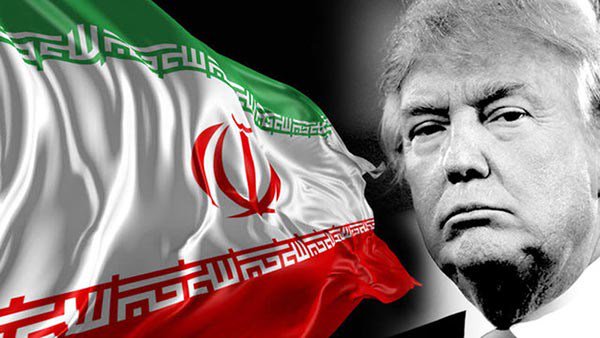Iran Tests The Trump Administration
Yigal Carmon and A. Savyon/MEMRI/May 09/17
Introduction
After its 100 days of restraint and hiatus in its anti-U.S. threats and incitement following U.S. President Donald Trump’s inauguration,[1] the Iranian regime has begun to cautiously change its direction.
Iranian spokesmen from the ideological camp are taking a more aggressive tone towards the U.S., and have also resumed criticizing the administration of Iranian President Hassam Rohani and the decision makers in the regime who have been deterred by the displays of American anger – that even led to the cancellation of a long-range missile test.[2] Furthermore, the verbal Iranian attacks on the U.S. have been in the name of the entire resistance axis – Iraq, Syria, Hizbullah, Yemen – with an emphasis on Iran’s mission, with which Iran’s Islamic Revolutionary Guards Corps (IRGC) is charged: spreading (Shi’ite) Islamic rule worldwide.[3]
Iran is also continuing its provocations against American vessels in the Gulf. Although these provocations are significantly fewer in number than during the Obama era – only seven so far – their continuation indicates an attempt to test the reaction of the Trump administration.
On May 8, 2017, Iran announced its intention to launch two communications satellites in the near future.[4] If the launch takes place, Iran will be using long-range missiles, regarding which it was “put on notice” by the Trump administration in early February 2017 – and following this warning Iran cancelled a planned long-range missile launch.[5]
Why The Change?
The Iranian regime is testing President Trump because of the signs that Trump’s positions do not line up with his statements against the JCPOA and against Iran’s activity to destabilize the region. For example:
The JCPOA – From Criticism To Endorsement
In April 2017, the Trump administration sent Congress a letter confirming that Iran was meeting the demands of the JCPOA.[6] With this action, the administration legitimized the conditions set out in the Obama era that allow for no real inspection of Iran’s military nuclear development. The Trump administration could have postponed the confirmation that Iran is abiding by the JCPOA,[7] or could have exposed the flawed terms of inspection set out by the Obama administration that were aimed at shielding Iran from serious and intrusive inspection – but chose not to, and instead gave these terms credence.[8] The Iranian side even warned the Trump administration not to dare to reveal these agreements and the administration heeded the warning. [9]
Furthermore, in April 2017, the U.S. joined the G-7, which states that it supports the JCPOA: “We support the Joint Comprehensive Plan of Action (JCPOA) as an important contribution to the non-proliferation regime.”[10] That is, the Trump administration has moved from criticizing the JCPOA to endorsing it.
It should be noted that the U.S. also joined decisions of the joint committee of the JCPOA in April 2017 aimed at giving Iran additional incentives in the framework of civilian nuclear cooperation with it.[11]
Iranian Activity To Destabilize The Region – Trump Administration: Statements Against, Actions For
In Congress, U.S. Secretary of State Rex Tillerson harshly warned against Iranian regime activity in the region,[12] but the warning was contradicted by the following Trump administration actions:
At the end of his statements against Iran’s activity, Tillerson announced that the administration had launched an interagency review of its Iran policy. This review appeared to be unnecessary in light of the resolute statements that Tillerson had just made, and of other statements by the Trump administration regarding Iran’s activity in the region. What this announcement means in practical terms is that Senate legislation against Iran will be pushed off until after the conclusion of the review, because the Senate will not continue legislating while a White House review on the same issue is underway.[13]
U.S. Secretary of Defense James Mattis announced during his April visit to Saudi Arabia that the solution to the internal conflict in Yemen lies with the UN: “Our goal is for that crisis down there [in Yemen] – that ongoing fight – to be put in front of a U.N.-brokered negotiating team and try to resolve this politically as soon as possible… It has gone on for a long time.”[14] It should be noted that turning to the UN in this matter serves Iran’s interests and is also characteristic of President Obama’s approach.
The Trump administration has supported the Russia-Turkey agreement, the De-Escalation Zones Plan, and by so doing recognized Iran’s role as a guarantor of the plan, legitimizing the continued presence of Iranian forces in Syria. Later, the U.S. State Department made an announcement that was internally contradictory, that included both actual support for the agreement and expression of reservations about it. The U.S. is not party to the agreement, it said, but “[w]e appreciate the efforts of Turkey and the Russian Federation to pursue this agreement and have encouraged the Syrian opposition to participate actively in the discussions despite the difficult conditions on the ground.” However, it added: “We continue to have concerns about the Astana agreement, including the involvement of Iran as a so-called ‘guarantor.’ Iran’s activities in Syria have only contributed to the violence, not stopped it, and Iran’s unquestioning support for the Assad regime has perpetuated the misery of ordinary Syrians.”[15]
In a briefing of journalist Laura Rozen, known to be a supporter of the Obama administration and its Iran policy, a White House official clarified that “Iran supports Hezbollah and sends weapons to support the Houthi rebels. The Trump administration will demonstrate its dissatisfaction with Iran’s behavior in the region with actions.” Yet he added: “If Iran wants to talk about it, Islamic Republic officials can pick up the phone and call us.”[16]
Assessment
If to date the Iranian regime has assessed that the Trump administration’s Iran strategy differentiates between the JCPOA – against which it has decided not to act – and Iran’s activity in the region – against which it has promised to take measures – it is now clear that even the latter involves words only at this time that are contradicted by and even surpassed by deeds, such as in the matter of its endorsement of the JCPOA. Also in the matter of the Russian plan it has shifted to supporting it, which means that it has legitimized Iran’s activity in Syria – contrary to all the statements it made previously.
Nevertheless, the Iranian regime is not certain that these are shows of Trump’s and the U.S.’s weakness and submission, because the administration responded strongly – with a focused bombing raid – to the Assad regime’s use of chemical weapons. Therefore, they consider that Trump may be marking out his red lines – i.e. he will react to the use of weapons of mass destruction or long-range missiles, but in other areas, such as Iran’s spread through the region by use of its proxies, the administration will, despite its statements, refrain from taking action – and in such cases is even open to Iran “pick[ing] up the phone.”
Iran realizes that this approach by the Trump administration is likely to shift after the completion of the interagency review announced by Tillerson and also if Iran continues its direct provocations against the U.S. military. Therefore, it should be assumed that in the short term, Iran will continue testing, by various means including violent provocation, to see whether the gap between the Trump administration’s statements and its actual acts will contract or expand.
One way in which the Iranian regime is testing Trump is the announcement by the Iran-sponsored Shi’ite Al-Hashd Al-Sha’bi militias in Iraq that they will move towards Mosul – a move opposed by the U.S. According to Iraqi sources, the U.S. has warned that if Al-Hashd Al-Sha’bi do indeed move towards Mosul, it will bomb them from the air. Hashd Al-Sha’bi forces did set out towards Mosul on April 24, 2017, but turned back after receiving messages from Iraqi elements that the Americans were “serious in their threats.”[17]
*Y. Carmon is President of MEMRI; A. Savyon is Director of the MEMRI Iran Project.
[1] See MEMRI Inquiry and Analysis No. 1305, Facing Trump Administration, Iran Shows Fear And Military Self-Restraint, Halts Provocations, Threats, And Incitement – While Boosting Morale At Home And Delegating The Bulk Of Conflict To Its Proxies, March 20, 2017.
[2] Kayhan (Iran), April 23, 2017. Amir Ali Hajizadeh, commander of the IRGC missile division, said on March 9, 2017: “We have a non-military satellite launching missile and are taking it to the warehouse because of an angry American tone?!… How long will we be blackmailed and how long will we compromise? If we do not change our strategy and continue to act according to the instructions of some of the [Iranian] officials who are stuck in the quagmire, our situation will get worse every day.” Tasnim (Iran), March 9, 2017.
[3] See forthcoming MEMRI report on this issue.
[4] ISNA (Iran), May 8, 2017.
[5] See MEMRI Inquiry and Analysis No. 1305, Facing Trump Administration, Iran Shows Fear And Military Self-Restraint, Halts Provocations, Threats, And Incitement – While Boosting Morale At Home And Delegating The Bulk Of Conflict To Its Proxies, March 20, 2017;
[6] State.gov/secretary/remarks/2017/04/270315.htm.
[7] See, for example, article by former U.S. Ambassador to the UN and former undersecretary of State for arms control and international security affairs, Washington Times, April 26, 2017.
[8] State.gov/secretary/remarks/2017/04/270315.htm.
[9] On February 12, 2017, Iranian Majlis Foreign Policy and National Security Committee chairman Alaa Al-Adin Boroujerdi warned of the possibility that Trump would reveal Iran’s secret documents in the JCPOA: “If Trump wants to publish the secret documents between Iran and the International Atomic Energy Agency, this will constitute a violation of the IAEA’s promise that it undertakes not to give any country, including the U.S., Iran’s secret and nuclear documents.” Borojerdi.ir/main/index.php?Page=definition &UID=346771.
[10] Esteri.it/mae/resource/doc/2017/04/g7_-_joint_communiqu_final.pdf.
[11] Eeas.europa.eu/headquarters/headquarters-homepage_en/25069/25%20April%202017%20meeting%20of%20the%20JCPOA%20Joint%20Commission
[12] State.gov/secretary/remarks/2017/04/270315.htm
[13] This is a familiar and well-known tactic. When an administration seeks to block a legislative initiative in the parliamentary body, it announces an initiative of its own on the same topic. In this instance, Tillerson’s announcement included no information about when the review would be completed.
[14] Stars and Stripes, April 18, 2017.
[15] State.gov/r/pa/prs/ps/2017/05/270647.htm.
[16] Almonitor.com, May 4, 2017.
[17] Alquds.co.uk, April 27, 2017.





















